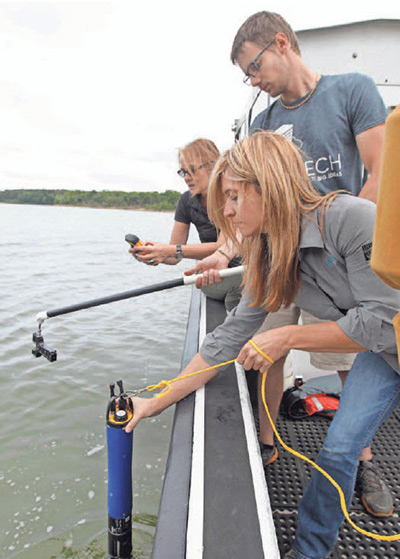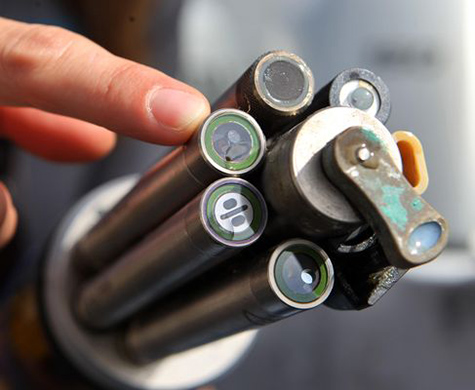NASA Involved in Local Toxic Algae Issues
(This article originally appeared in Cincinnati Enquirer. Author, Carrie Blackmore Smith, csmith@enquirer.com)
Little bright-green flecks of algae, floating as deep and as far as the eye could see, greeted a group of scientists on the Ohio River Friday morning. They had pulled up in a boat with their scientific instruments to the spot where the region sucks up much of its drinking water through underwater intakes.
Water officials had hoped the situation would have improved by now, but tests show that the algae bloom – the largest ever recorded on the Ohio River – has expanded over the last week from a 500-mile stretch to a 600-mile stretch, according to authorities at the Ohio River Valley Water Sanitation Commission (ORSANCO), the organization that monitors the river’s health.
The researchers, two from the commission, one from Bowling Green State University and another from YSI (a company that makes high-tech water quality meters), prepped their equipment and waited. Until a Twin Otter, a twin-engine turboprop plane, came into view.
Aboard were NASA researchers, who had made the trip to Cincinnati from NASA’s John H. Glenn Research Center in Cleveland, with a hyperspectral imager and miniature spectrometers.
This technology has been used for a few years in NASA’s algal bloom observation project but it was the first time ever flying a swath of river near Cincinnati.
NASA has two primary goals with this project, said project manager Larry Liou, an earth science coordinator at NASA.
The first is to understand the capabilities and limitations of the equipment for future use by NASA in space and on Earth. This is the same technology that is being considered for a Mars mission, Liou said.
The second goal is to provide state and local authorities with more data to better understand the algal blooms. Each species on the planet – or beyond – has a different interaction with light, Liou explains, and with what they reflect or what they absorb. These instruments take a measurement that provides us with a spectral fingerprint that should always be identical and can eventually be identified.
Liou’s team is closing in on being able to determine what algae is toxic and what isn’t, from the air. Within about three years, Liou believes scientists will have such a degree of confidence and certainty in identifying these toxins through spectral imagery that laymen will be able to interpret the images themselves – even potentially obtain them themselves with unmanned aerial devices.
“Water sampling is very time consuming,” Liou said. “Taking samples from all over a lake, or a river, it’s unachievable almost.”
At this point, NASA is taking these images twice a week over Lake Erie, and providing information to water utility officials. Those include a focus along the lake near Toledo, where the level of toxins in the water led to bans on drinking or bathing in tap water in September 2014.
But until they have more confidence in the results, scientists like the ones on the Ohio River Friday (pulled together by Confluence, an organization focused on water quality technology in the region), will test samples at the same time to determine the reliability of NASA’s images.

YSI EXO multiparameter sonde with multiple sensors installed.
Fortunately, the algal bloom doesn’t appear to be causing much immediate damage to the region. No deaths of fish or animals have been reported. No cases of human sickness have been identified as caused by this bloom, though animals have died from the toxin and people have been diagnosed with rashes, nausea, severe headaches and liver damage related to other blooms.
This algae problem only seems to be getting worse, though, and isn’t going away any time soon, said Confluence Executive Director Melinda Kruyer.
“It’s great when we can get so many groups collaborating on this important issue,” Kruyer said.
Additional Blog Posts of Interest
Harmful Algal Blooms | Everything You Need to Know
Harmful Algal Blooms | What's in Your Source Water? [Infographic]
Online Cyanobacteria Monitoring in Source Water Treatment
The Basics of Chlorophyll Measurement in Surface Water